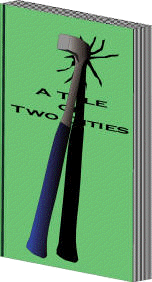Geology Through Literature:
Hans Christian Andersen's: The Ice Maiden (1861)
The Ice Maiden (1861)
They had made the greater part of the journey, had climbed the highest ridges to the snowfields and could already see her native valley with the familiar scattered cottages; they now had only to cross the upper part of one great glacier. The newly fallen snow concealed a crevasse, not deep enough to reach the abyss below where the water rushed along, but deeper than a man's height...
The glacier lies like a rushing stream, frozen and pressed into blocks of green crystal, one huge mass of ice balanced on another; the swelling stream of ice and snow tears along in the depths beneath, while within in it dwells the Ice Maiden, queen of the glaciers.
Glaciers are essentially as Andersen describes them, big piles of ice that slowly move across the landscape. Mountain glaciers in particular are known for flowing down valleys, like rivers. In the upper part of the mountains, where it is colder, snow builds up over time. As more and more snow is dropped on the top of the mountain, eventually it starts to get compacted in the vertically lower layers, forming ice. As more and more ice builds up, the glacier starts to flow, like molasses, down the valleys. As the glacier moves down the valleys, the ice picks up and freezes small and large pieces of rocks and drags them along on the bottom of the ice. These rock fragments then grind down into the bedrock over which the glacier flows. Eventually the glacier reaches an elevation where it is too warm for the ice to remain frozen all of the time (like in the upper regions) and it starts to melt. Towards the end of the glacier where all of it has melted away, it acts like a conveyor belt, carrying all of the debris it eroded away and piling it up into one big pile of glacial debris called a moraine.
 |
| Glacial meltwater pathways. Image courtesy of Antarctic Glaciers. |
Due to differences in temperature from the upper surface of the glacier and the bottom depths, the upper layers will sometimes melt from warming by the solar rays. This occurs even in the coldest of temperatures due to the ability of the sun's energy to melt the ice. This melted water then flows down into the glacier through large cracks in the ice known as crevasses. This meltwater will sometimes then flow all the way to the base of the glacier along the bedrock where streams can be formed.
 |
| Snow covered crevasse. Image courtesy of SwissEduc. |
Also as the glacier moves, the whole glacier may not always flow as one solid, cohesive unit. Going over uneven terrain, or variations in the width of the valley, will alter how the glacier flows. These flow changes then have the potential to crack the ice. These cracks are known as crevasses, and sometimes the crevasses can go from the surface all the way to the base of the glacier, which in some instances could be hundreds to thousands of feet thick. These crevasses are also often covered over with a thin layer of snow due to variations in movement of the ice. These thin crusts, or bridges, of snow make walking across the surface of a glacier a very dangerous thing to do if you don't know what you are doing.

No comments:
Post a Comment
Due to the large number of spam comment (i.e. pretty much all of them). I have turned off commenting. If you have any constructive comments you would like to make please direct them at my Twitter handle @Jazinator. I apologize for the inconvenience.
Note: Only a member of this blog may post a comment.